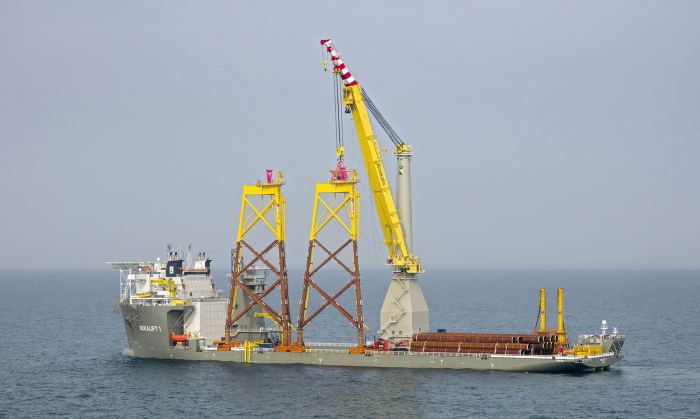The world population continues to increase steadily and it will rise from 7.6 billion today to a staggering 9.8 billion in 2050 according to the UN Department of Economic and Social Affairs. This development is leading to unprecedented urbanization along coastlines and in delta regions across the globe. With its hydraulic engineering activities Boskalis is involved in many projects to alleviate the challenge of land scarcity most of these regions are facing.
Han Meijer, Professor of Urban Design at Delft University of Technology, explains: “It is a fact that most population growth now is on the coast and in delta regions. That will continue in the future and cities are growing rapidly in these areas. For example, fifty years ago, there were only two cities which had a population of more than 10 million; now there are almost forty.”
People flock to the delta regions because of the fertility of the land and access to water, which is ideal for agriculture and fishing. Additionally, these areas are home to major industrial and transport hubs, and therefore employment opportunities.
Smart and adaptive
Professor Meijer points out that these deltas are also very vulnerable to extreme weather events, citing Hurricane Katrina’s and Hurricane Sandy’s impact on New Orleans and New York respectively. And this is one reason more attention needs to be paid to the natural characteristics of the world’s deltas.
“We aren’t opposing urbanization but the characteristics of the coast and deltas are dynamic. That requires smart – and adaptive – delta management to ensure these delta regions are prepared for possible changes in the future, including climate change.”
“When considering land reclamation options to cope with this growth in delta urbanization, several aspects must be kept in mind to avoid damaging coastal zones. In China for instance, development has not been considered from an ecological point of view in a number of coastal areas, with an adverse effect on biodiversity as a consequence.”
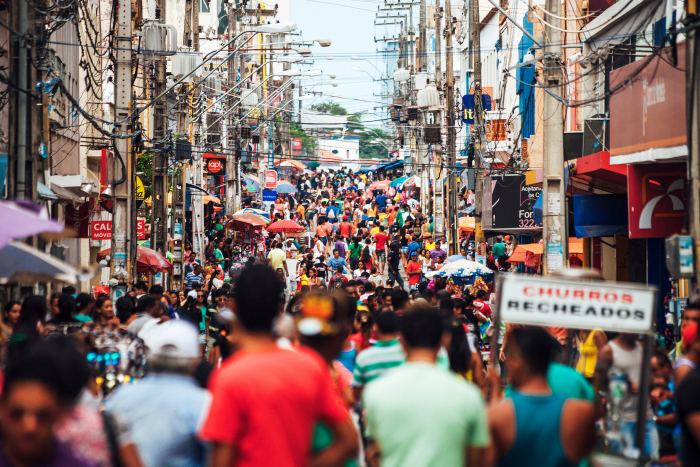
Combining functions
As well as economic development, there is the issue of the energy transition and the change in the flows of raw materials, Professor Meijer points out. For example, a project has been mooted in the Port of Rotterdam to build a new “energy island” off the Dutch coast to support the construction and maintenance of offshore wind farms in the North Sea. This could be interesting if multiple functions can be combined, he says. In addition to supporting renewable energy production the island could be utilized for coastal protection purposes, in combination with urban development and/or leisure. “There is a danger of tunnel vision with developments like this. Ideally, reclamation projects should combine as many functions as possible.”
Boskalis and the Dutch hydraulic engineering sector can play a crucial role in developing these delta areas responsibly, according to Professor Meijer. For example by reusing sediment dredged from estuaries in smarter ways to prevent erosion in other places or to reclaim land and make delta areas less vulnerable. In his view, Building with Nature is a welcome initiative and projects such as the Dutch inland water management program ‘Room for the River’ and the ‘Sand Motor’ pilot project for coastal protection are interesting examples. “One of the most important ways of dealing with water is making space for it,” he emphasizes.
Tough decisions
However, he points out that although there was a lot of talk about water management initiatives in many countries after the hurricanes of recent years, little has changed in reality. Hardly any serious measures have been implemented outside of the Netherlands, he says.
The rapid growth in the population and urbanization will require tough decisions to make sustainable solutions possible, he stresses. While disappointed by the pace of change, Professor Meijer does say that at least people are now convinced that something needs to be done. Public pressure will lead to measures being implemented, he hopes.
“In the Netherlands, it took us almost 1,000 years and the country probably had three to four major floods every decade between the 14th and the 16th centuries, and even in the 19th century. A rapid change of mindset is needed and certainly decision-taking needs to speed up!”
For decades Boskalis has been executing land reclamation activities across the globe in response to the needs of ever-increasing city populations, such as the projects highlighted in Amsterdam, Panama City and Singapore. Nowadays, this unique expertise is also being used for large-scale nature restoration in the Markermeer lake in the Netherlands.
Residential islands near Panama City
The impact of population growth can also be seen in Panama where Boskalis has built two artificial islands off the coast near the residential area of Punta Pacifica in Panama City.
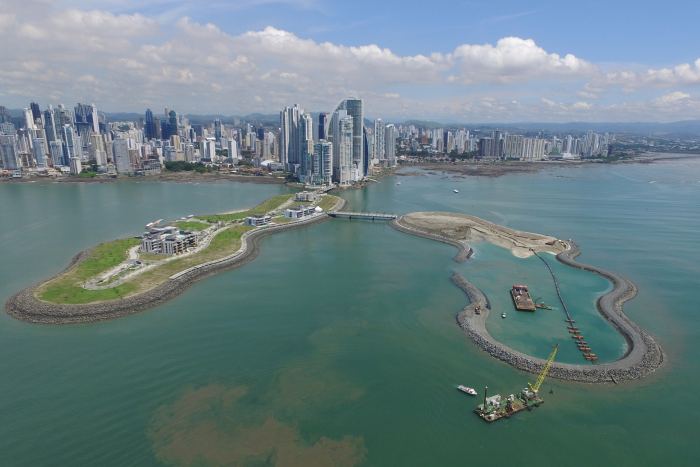
Two artificial islands near the residential area of Punta Pacifica, Panama City
The first Punta Pacifica island, Santa Maria, was built by Boskalis between 2011 and 2013. Ten hectares of premier real estate land was created by using 650,000 cubic meters of rock to form a perimeter and filling it with 1.4 million cubic meters of sand using a large trailing suction hopper dredger. A bridge was also built to connect the island to Panama City.
A RAPID CHANGE OF MINDSET IS NEEDED AND CERTAINLY DECISION-TAKING NEEDS TO SPEED UP!
The construction of the second Island, La Pinta, began in September 2015 and was completed in July 2017. This island covers 8.7 hectares and measures approximately 600 by 150 meters. The dredging activities were executed by the grab dredger Alex that worked alongside the self-propelled split barges Corksand and Longsand and the non-self-propelled split barge Henares. The next step was the construction of the sea wall, which was covered on the land side with 40,000 square meters of geotextile protected by several layers of rock with a total volume of 600,000 cubic meters. As the sea wall had to be raised, more than 500,000 cubic meters of soft soil was eventually replaced with rock and sand. Finally, the trailing suction hopper dredger Willem van Oranje pumped the sand to the core of the island after which the soil was compacted.
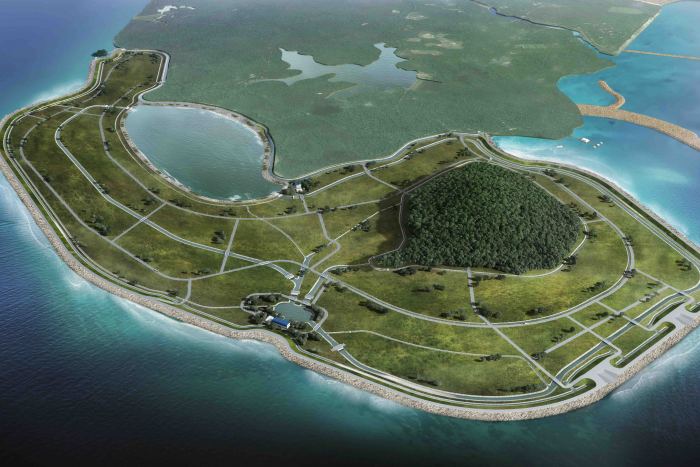
Artist impression of the Tekong polder, Singapore
First polder in Singapore
Boskalis recently launched another groundbreaking project on the island of Pulau Tekong at the eastern edge of Singapore: the construction of the country’s first polder. Boskalis is actually completing a development that began 15 years ago. Singapore started reclaiming the area at that time and one section was even raised to a few meters above water level. However, that development was terminated because not enough sand was available. Boskalis is now reusing the sand reclaimed at that time to raise the entire area to a level approximately one meter above the low water level. The scope includes draining the polder, strengthening and closing the 10-kilometer-long dike that surrounds the area, and installing and building the entire drainage system, including the channels, pumping stations and pump housing. The polder will cover 810 hectares and is being created in a lagoon that is still open to the tides in two locations.
THE RAPID GROWTH IN THE POPULATION AND URBANIZATION WILL REQUIRE TOUGH DECISIONS TO MAKE SUSTAINABLE SOLUTIONS POSSIBLE.
A crucial part of the project is the closure of the dike for which Boskalis has developed an innovative closure method. The polder is created in small partitions and the work is being executed in two stages. In the first, the polder will gradually be extended so that water movement in the openings becomes less intensive. This allows the dike to be closed in a controlled way in the second phase by placing rock and using a dedicated structure designed by the company. It will take four years to create the polder. This ‘new’ approach in Singapore is actually based on land reclamation techniques that have been in use in the Netherlands for 400 years.
The expansion of Amsterdam
In the east of Amsterdam in the Netherlands, Boskalis is hard at work with a partner creating a new island that will add an area the size of 164 soccer fields in the city! The IJburg Beach Island in the IJmeer lake will cover 82 hectares, and the client, the City of Amsterdam, hopes to extend that by another 53 hectares in the follow-up phase. Ultimately, about 18,000 homes and 45,000 people will be located on IJburg as a whole. Forty percent of all the homes built on the Beach Island will also be for social housing.
The existing section of IJburg was created by Boskalis and another partner more than ten years ago. In addition to the creation of the Beach Island that requires the delivery and processing of around 9 million cubic meters of sand, the construction work includes a beach area for leisure purposes, three breakwaters and a nature area measuring more than three hectares, which will be made up of an area with reeds and a mussel bed.
Sustainability is an important consideration in the project. Boskalis is using a biofuel blend as a source of power for its equipment with the aim of cutting emissions of nitrogen oxides (NOx) by fitting its equipment with “selective catalytic reduction” systems. All this means that operations take place well within the strict environmental requirements. Work on this new part of Amsterdam is due to be completed in May 2020.
THE COMBINATION OF HYDRAULIC ENGINEERING AND ECOLOGY MAKES THIS PROJECT VERY SPECIAL FOR BOSKALIS.
Marker Wadden – Nature restoration in the Netherlands
In early 2016, Boskalis started on the construction of one of the largest nature restoration projects in Western Europe - the Marker Wadden - a bird paradise consisting of a 1,000-hectare landscape above and below the waterline.
The combination of hydraulic engineering and ecology makes this project very special for Boskalis. The company is one of the founders of the Building with Nature philosophy and its related techniques are central to the project, in which ‘building with silt and soft clay’ is one of the major breakthroughs.
With the construction of natural islands using sand, clay and silt, the ecologically impoverished Markermeer lake is being transformed into a dynamic area rich in flora and fauna which is enjoyed by nature lovers and water sports enthusiasts alike. And as nature takes over, the Marker Wadden will develop into a unique ecosystem in which biodiversity is enhanced, water quality is improved and more opportunities for recreation are created.
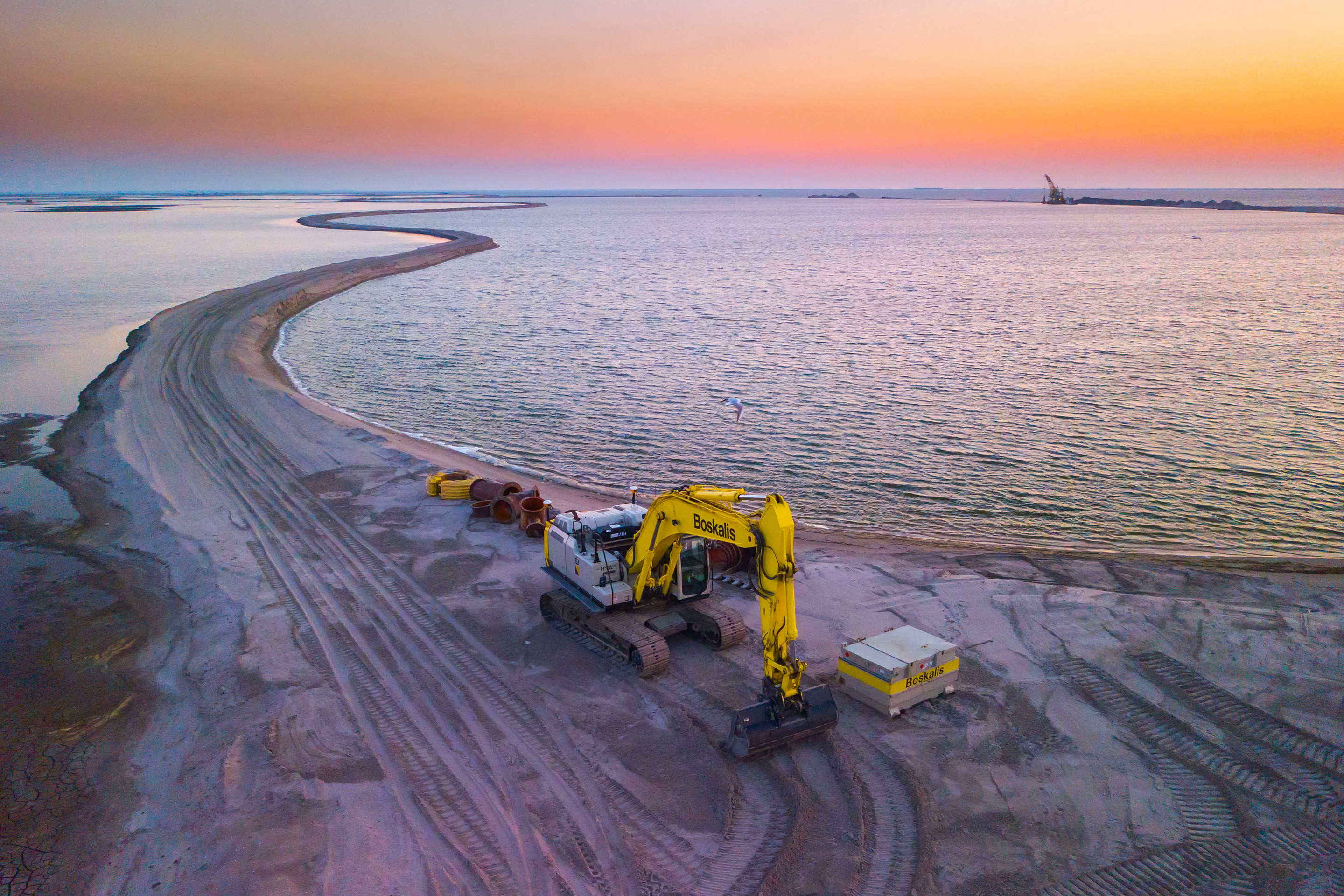
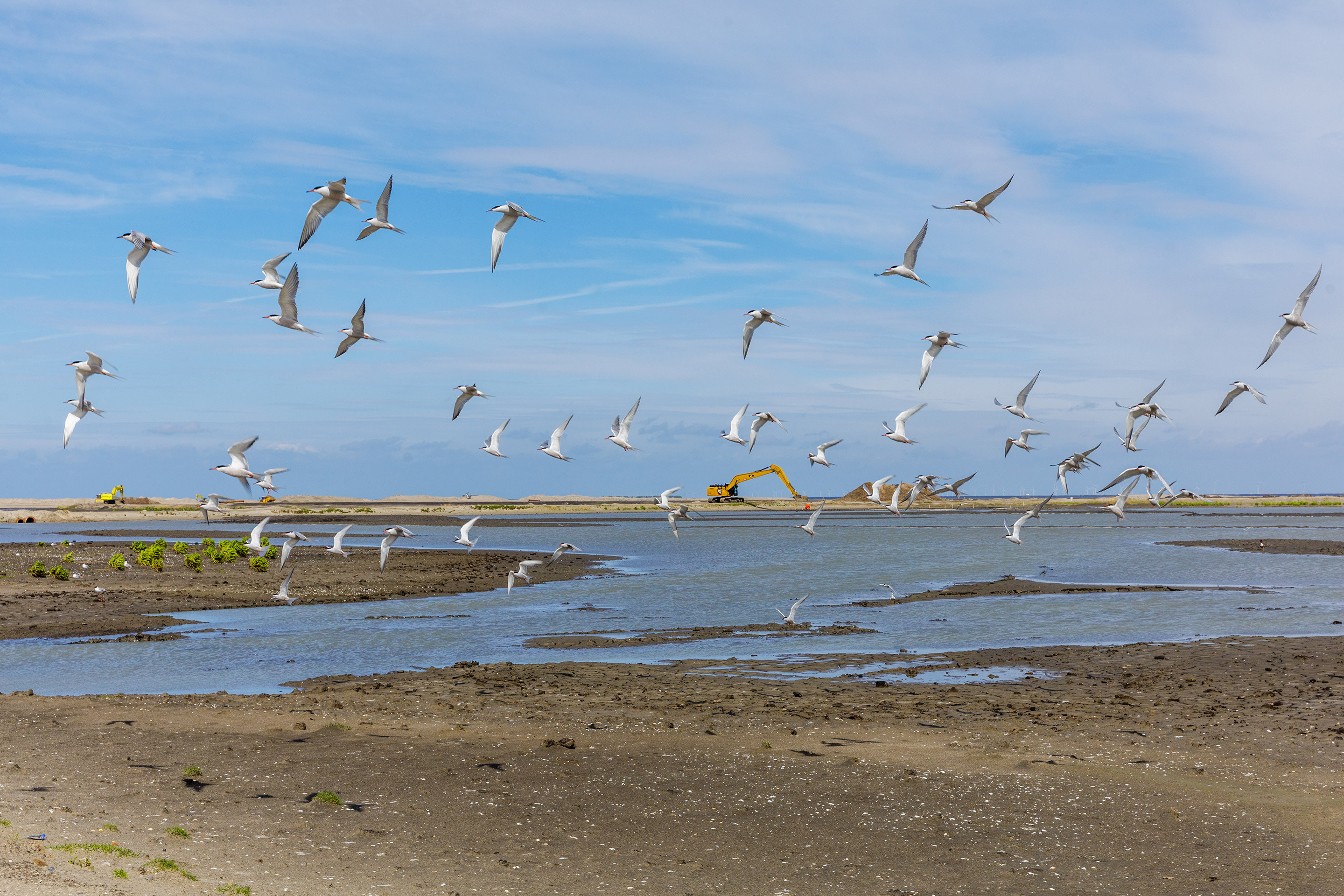
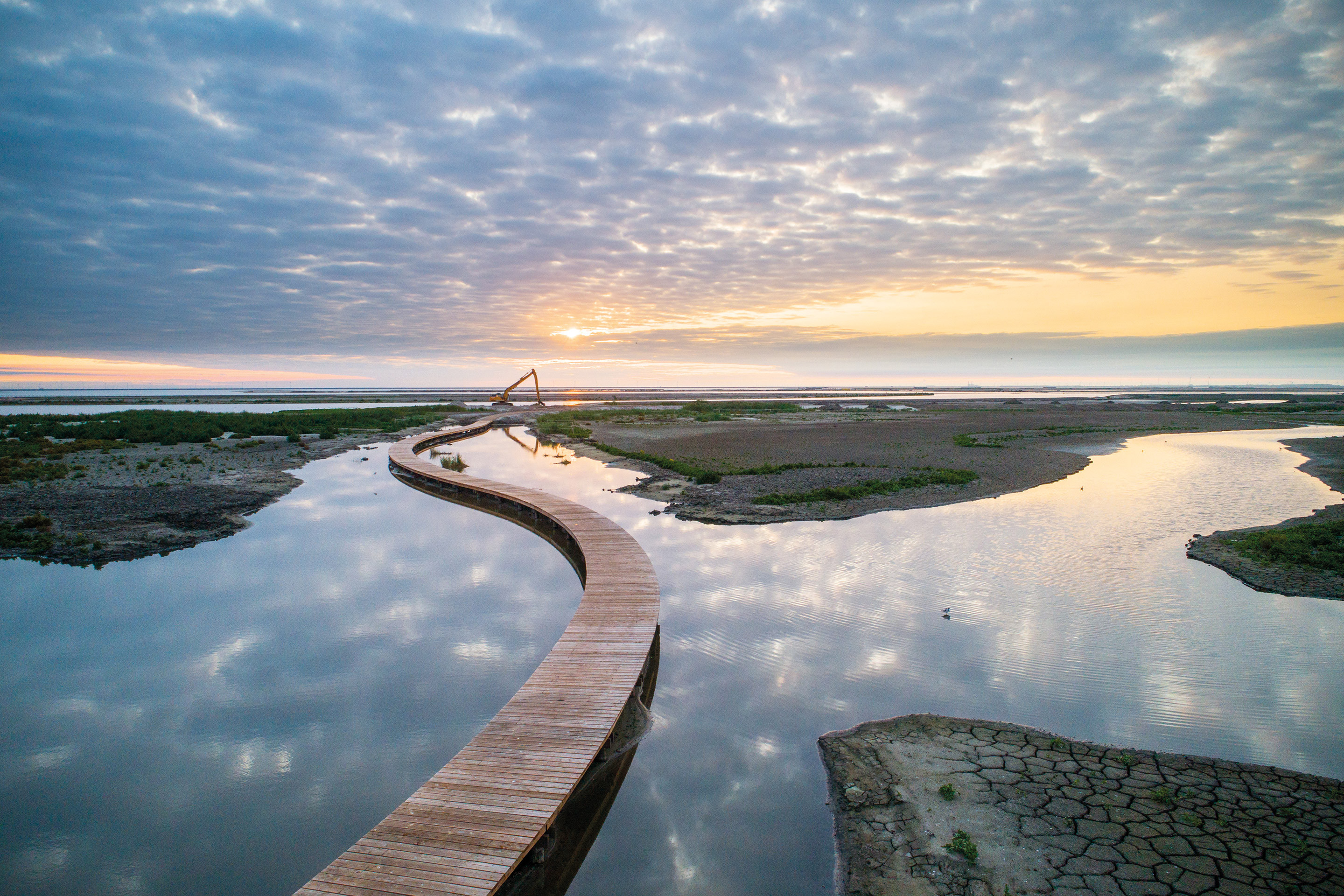
The largest island measuring 250 hectares is the only one accessible for visitors and this was opened to the public in September 2018. And although the first island is only two years old, 2,000 breeding pairs of pioneer birds such as the common tern and the avocet have already been counted there. In addition, a dramatic increase of plankton in the waters surrounding the Marker Wadden is being observed, providing an important food source for fish and birds in the Markermeer lake.
